The early 50s saw a crisis in the USN's air defenses. Jet aircraft had completely overwhelmed the manual CIC1 techniques used during WWII. The obvious solution was automation, and the British and Canadians had made some early strides in the area, but neither was sufficient for the USN's needs. On land, the USAF had created SAGE, a computerized system to track incoming Soviet bombers, but the 250-ton computers that drove it were much too large to take to sea. Something better would be needed.
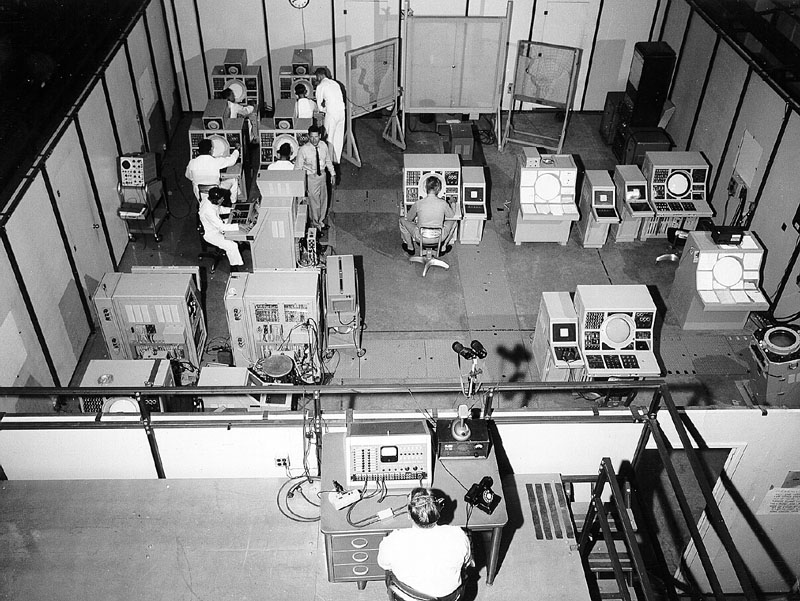
The prototype NTDS CIC ashore
Fortunately, the invention of the transistor allowed such a system to be built, and for computers to go to sea on a grand scale for the first time. The architects of this system, known as the Naval Tactical Data System (NTDS), took the bold step of using general-purpose (programmable) computers even though many thought that only a special-purpose computer would be fast enough. This had a number of advantages. The system, both software and hardware, would be easy to upgrade, and making it more powerful would just involve adding more computers, giving useful commonality between large ship and small ship systems.
The basic idea behind NTDS was simple. Operators would view radar signals on their consoles, "hooking" potential tracks. Any track hooked three times in succession would be entered into the computer's memory, where it would be updated based on the course and speed it had been "hooked" at.2 This was all very much like what CDS had allowed, and what made NTDS revolutionary was the fact that all of the tracks were stored in the same memory, giving unprecedented flexibility. NTDS could take a track, send it to another ship that hadn't seen it yet via digital datalink, put it on a display along with a specific subset of other tracks, and automatically compare several potential targets to determine which one was the greatest threat. If it needed to be dealt with, NTDS could recommend the appropriate weapons, including interceptors3 or missiles, although it was intended as an aid to human decisionmakers, and the call ultimately remained in their hands.
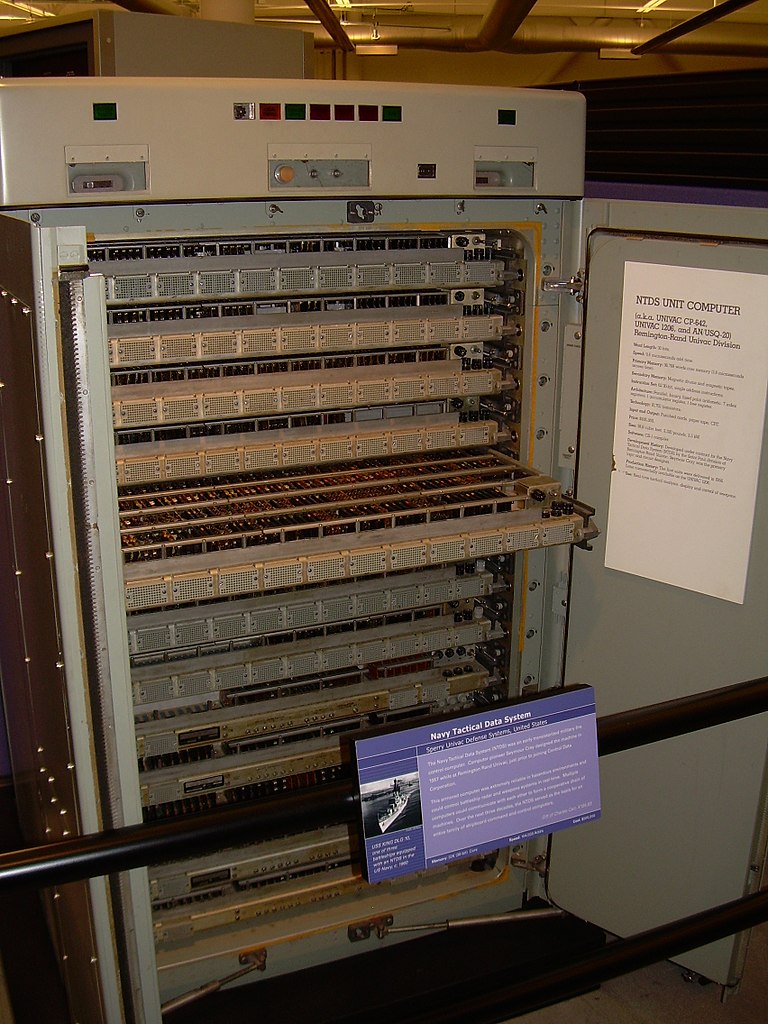
An AN/USQ-20 computer
NTDS was originally built around the AN/USQ-17 computer, designed by the legendary Seymour Cray, although the first operational systems used the improved USQ-20. Both operated on a 30-bit word, with 32,768 words of core memory. The smallest system used two redundant computers and could follow 128 tracks, while larger ships had four computers and memory for 256 tracks.
But as impressive as the computers were for the time, the network capabilities of NTDS were equally critical. One master ship called roll, and each "picket" responded in turn with any new or updated tracks it had for the group. As these messages were sent regularly, it meant that every ship had an up-to-date picture of the battle, even if it missed an occasional message. Previously, the loss of the flagship had usually destroyed the flag staff's plot, dealing a serious blow to the fleet's situational awareness. With NTDS, another ship could take over automatically, and the net continued unhindered. To support this, reliable communications were needed. The initial plan was to use line-of-sight radio, but the USN adopted widely-dispersed formations to protect against nuclear attack. HF radio, capable of reaching far over the horizon, was used instead, with the required bandwidth being achieved through the use of 30 discrete HF signals passed through a distinctive discone antenna. This protocol, which could pass commands as well as tracks, was called Link 11.4
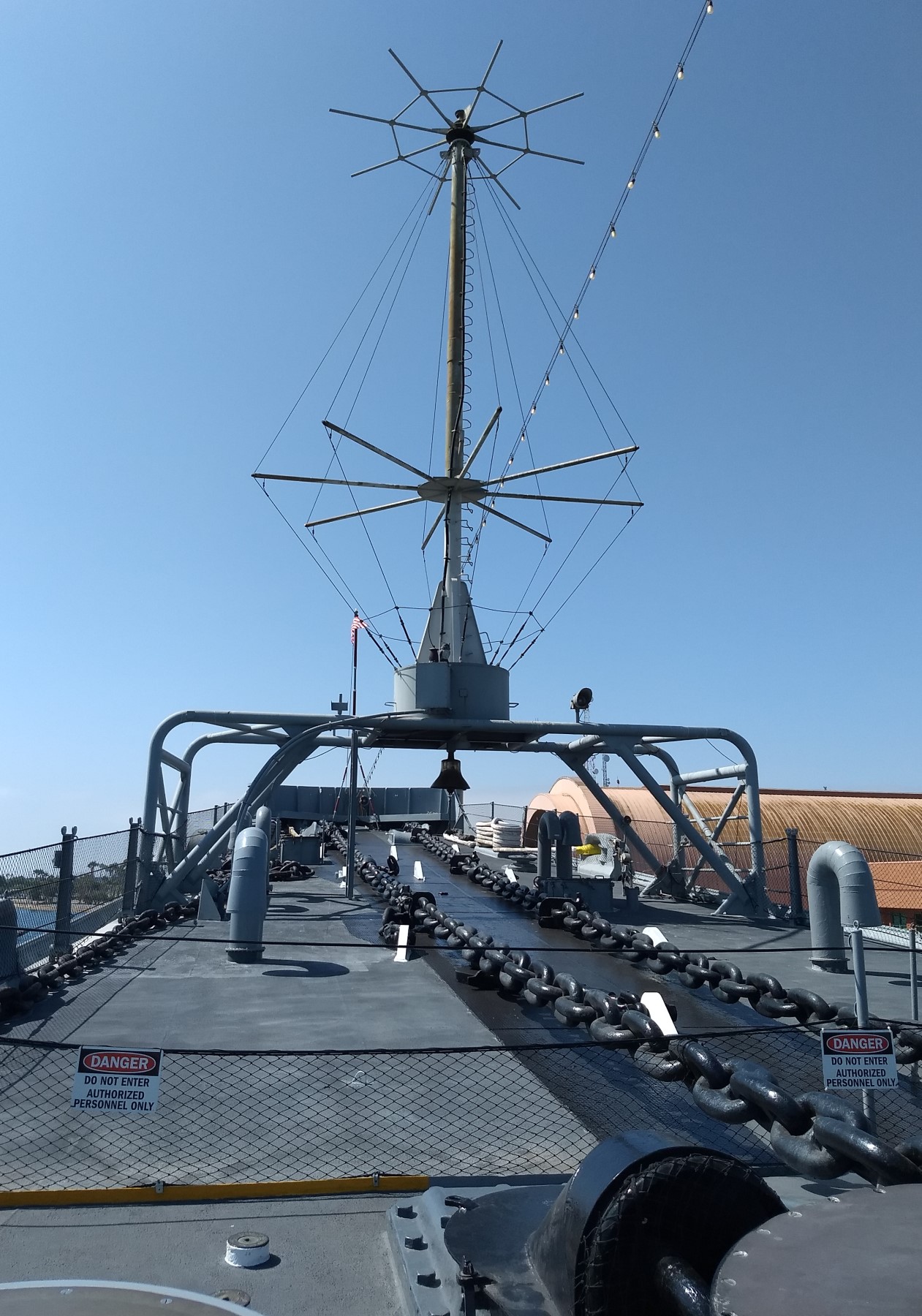
The Link 11 discone antenna aboard Iowa
To give smaller ships, or vessels which had not been fitted with NTDS computers, some of the benefits of the system, a second link, known as Link 14,5 was developed. This used a teleprinter on the receiving ship, which would list contacts to be plotted manually by the ship's crew. In practice, it didn't work very well because the picture changed too fast for the manual plot to keep up. Some efforts were made to create an automated Link 14 plotter, but were overtaken when the plummeting cost of computer hardware allowed all vessels to participate in Link 11.
Networking, while powerful, had a number of potential drawbacks. Multiple ships able to add tracks to the system raised the possibility of duplication overwhelming the system. The designers realized this and NTDS would automatically compare tracks to check for duplicates and consolidate them. This is easy enough in theory, but requires the ships to be accurately located relative to one another or the duplicates will appear like separate tracks. It wasn't until the 1980s that more powerful computers allowed the problem to be solved easily, an issue made more difficult by NTDS's use of a flat coordinate plane on a round Earth.
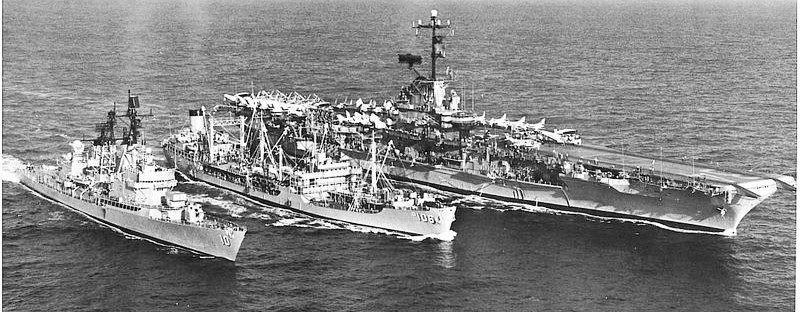
Missile frigate King and carrier Oriskany, two of the test ships for NTDS, refuel from oiler Navasota
NTDS had several implementation problems due to insufficient testing before production began. One was that the designers had vastly overestimated how quickly the radar operators could enter tracks into the system. When NTDS ships began to pull PIRAZ duty off Vietnam, it turned out that each operator could only watch about 5 tracks at a time, so a DLG with four operators could only really fill 20 of its 96 local track slots. The solution was a technology known as Beacon Video Processing (BVP), which monitored the IFF6 beacons of US aircraft and automatically entered them into the system. The first deployments off Vietnam in the late 60s greatly improved the air picture, and by the mid-70s, the technology was being applied to the raw radar signal, greatly reducing the demands on the operators.
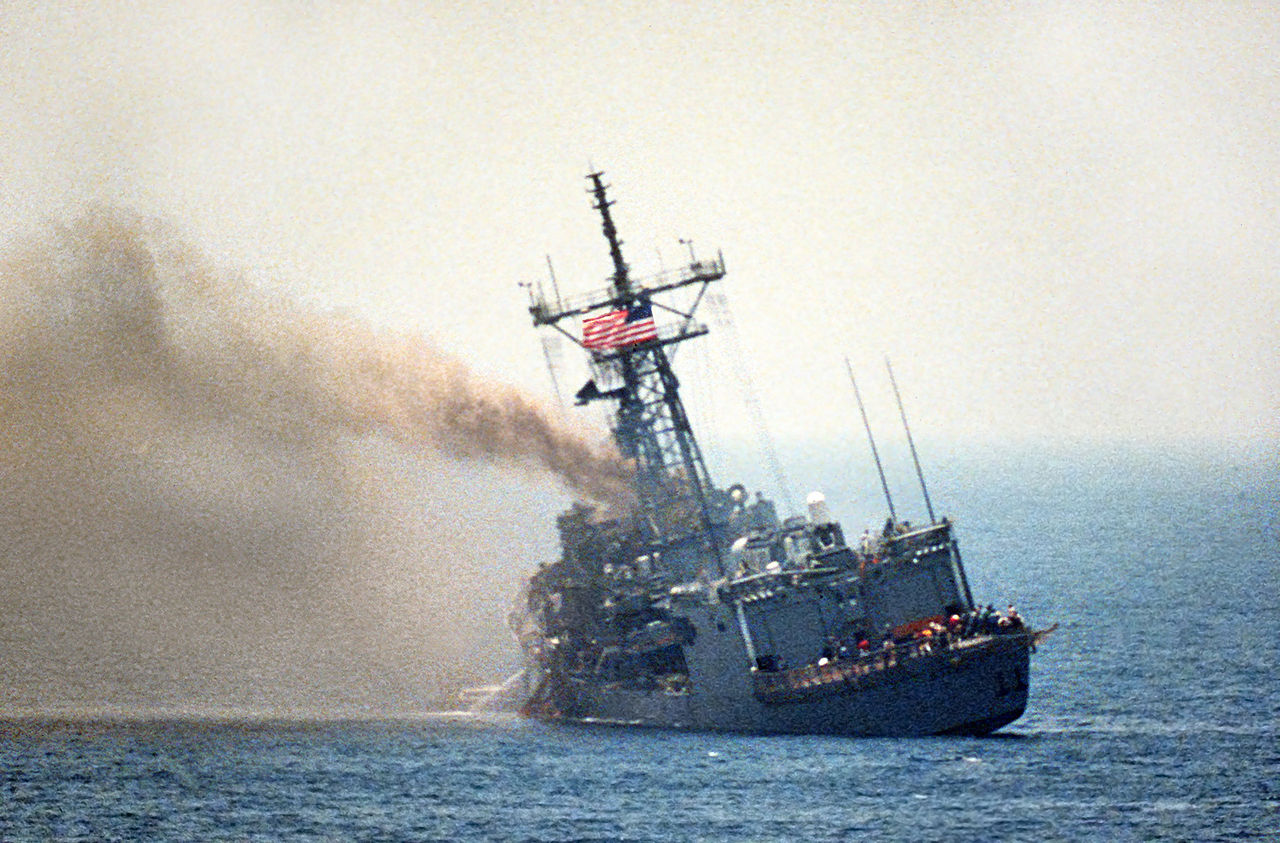
USS Stark burning
Another problem with NTDS was its limited vocabulary, a product of the Cold War battles it had been intended to fight. Tracks were categorized into one of three types: friendly, hostile, and unknown (presumed hostile). This became a problem in the 1980s, as the USN began to operate in situations between war and peace in the Persian Gulf. In 1987, the frigate Stark was attacked by an Iraqi jet with Exocet missiles. To this day, it's not certain if the attack was intentional, but one factor that hindered Stark’s response was the classification of the aircraft as Friendly by a nearby AWACS.
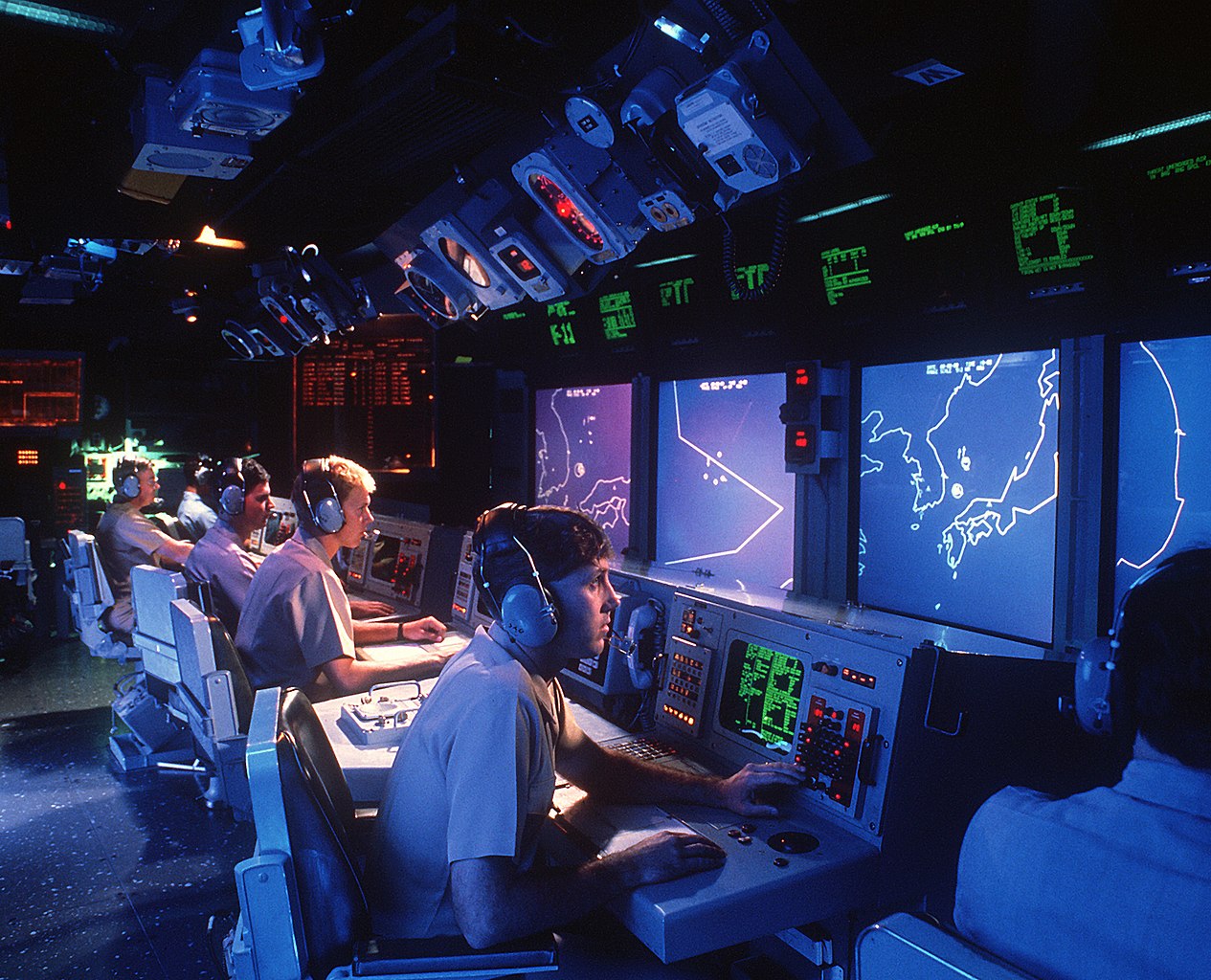
The CIC aboard Vincennes
Worse was to come the next year, when the cruiser Vincennes shot down an Iranian Airbus. While there were a number of failures that lead up to this, the limitations of NTDS played a major part. Vincennes was operating with the frigate Sides, and both ships detected the airliner and assigned track numbers, as well as a status of "Unknown, presumed hostile". NTDS recognized this, and discarded Vincennes’s track, replacing it with the one from Sides. However, the crew in Vincennes’s CIC didn't notice, which wouldn't have been a problem if their NTDS network hadn't merged with the network centered around the carrier Saratoga, 100 miles away. That network had assigned the same number Vincennes had originally used for the airliner to a fighter landing on Saratoga, and when the operator on Vincennes queried to find out what that track was doing, the response was that it was descending.7 Faced with an apparently-hostile track that they thought was descending into an attack run, the crew of the cruiser assumed it was an Iranian F-14, and shot it down.8 This incident was a stark demonstration of the limitations of the computerized CIC. The computer can produce enough information to overwhelm the user, and even if he knows better, the officer who has to make the call usually ends up acting as if it's completely accurate, occasionally with tragic results.
Despite these drawbacks, NTDS was vital to the ability of the USN to face the growing air threat. Initial tests estimated than an NTDS-equipped group could engage twice as many raids at 80-100 miles out as a conventional group could at 20-15 miles. The surface fleet could now face down air attack with some confidence, and the potential of computers was only beginning to be explored. We'll look at the further development of NTDS next time.9
1 Combat Information Center, the space charged with taking all of the data available to the ship and putting it in a usable form. ⇑
2 The system was unable to detect any changes in course or speed, and these had to be entered manually. ⇑
3 This also meant that it had to track things like the fuel state of said interceptors, another capability far beyond analog or special-purpose digital computers. ⇑
4 It had originally been intended to be Link II, but someone misread the Roman numerals. Link 1 was for SAGE. ⇑
5 Numbering for data links is completely baffling. I don't have a good explanation of this one. ⇑
6 Identify Friend or Foe, basically a radar transponder designed to say "yes, I'm on your side". ⇑
7 The display didn't show track numbers next to tracks. ⇑
8 There were other failings, including a display that only showed the centerline of the air traffic corridor, which the airliner didn't follow precisely, and a failed attempt to hail the Iranian jet, who wasn't monitoring that frequency. ⇑
9 For more information on the development of NTDS, see this account. ⇑

Comments
What is CDS in this context? I'm not sure that abbreviation was ever expanded.
CDS is the British Comprehensive Display System, discussed in Part 3.
Why was it the introduction of jets that overwhelmed the manual systems?
Just because the jets were faster than the Me-109s and Zeros that the old systems worked with?
I'd have guessed that it was numbers, not speeds, that were the limiting factor.
@doctorpat
Yes, it was speed. Speed meant that you had much less time to react to incoming enemies that they moved much farther between every update of your plot. The two factors together made tracking much, much harder.
Pretty much what cassander said. It took a certain amount of time for a raid to be tracked and plotted manually, and then fighters vectored in. It turned out that this was, on average, slightly longer than the amount of time it took for jet aircraft to go from the outer edge of radar range to their targets. It didn’t help that jets had, on average, lower RCS than prop planes, either.
@doctorpat In addition, the number of targets was trending sharply down in this period - the massed air fleets of WW2 replaced by much smaller numbers of more capable aircraft.
@Philistine
Ironically, the smaller number of attackers also made the problem harder. Massed fleets were much easier to detect on radar. By late WW2, massed attacks against the US fleet were suicidal because they'd be seen and fighters sent to intercept, but small numbers of kamikazes were consistently able to sneak through.
@cassander
Not exactly. It wasn't that the kamikazes were harder to detect, it was that they no longer had to mass in the numbers required by conventional raids, so they could send a bunch of raids at the same time, saturating the American CICs. The limits on raid handling discussed in Part 3 came largely out of the kamikaze raids.
@bean
seeing as how fewer planes actually had to be committed for a kamikaze strike, did the Japanese send out decoys along with the kamikaze attacks just to clog up the US CIC? I'm picturing sending in planes from various angles just far enough to get them noticed by CIC, then turning around while the actual kamikazes continue on. It would seem something like this would help spread out the fighter cover with minimal risk of losing additional planes, though I could see how it the precarious fuel situation might make it seem wasteful.
Not that I'm aware of. One of their big limitations was that they had very few pilots capable of long-distance navigation, and decoys would have required planes from that pool, too. (As a result, most kamikaze raids were one good pilot who would lead a dozen or so bad ones within visual range of the fleet, then go home. If the raid was intercepted and scattered before they got within visual range, it was usually ineffective.) The big advantage of the kamikazes was that you could do a bunch of dozen-plane raids instead of a few big ones. The problem for the CICs was how many separate raids there were, not how many planes were in each one.
Something that I'm still unclear on is how various generations of CICs have transmit the situational picture they create to the people in charge.
Obviously that's simple when you have a wave of bombers and just need to tell the fire directors where they're coming from.
But where was the Vincennes’s captain when he made the call to fire? Was he up on the bridge hearing only an audio report? Did he have a slaved plot on the bridge? Was he looking over someone's shoulder in the CIC itself?
This is something that has evolved over time. IIRC, by late WWII, captains were starting to migrate to the CIC, which had become standard over the next decade or two. These days, the CIC is where the ship is fought from, with the bridge remaining as a navigation/ship control location. I believe Vincinne's captain was in CIC when he made the call to fire.